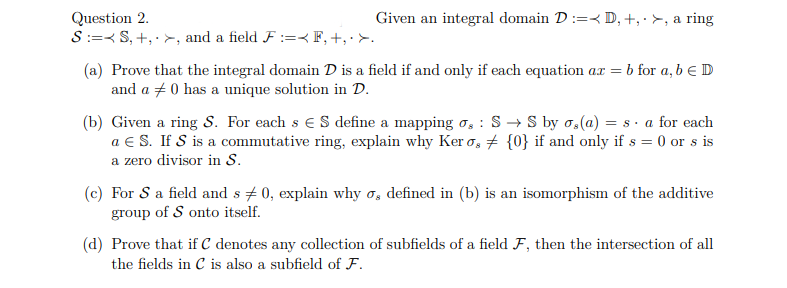SS, +, >, and a field F := F, +, . >. (a) Prove that the integral domain D is a field if and only if each equation ax = b for a, b € D and a 0 has a unique solution in D. (b) Given a ring S. For each s € S define a mapping og : SS by o(a) = s. a for each a € S. If S is a commutative ring, explain why Ker o, ‡ {0} if and only if s = 0 or s is a zero divisor in S. (c) For S a field and s‡0, explain why σ, defined in (b) is an isomorphism of the additive group of S onto itself.
SS, +, >, and a field F := F, +, . >. (a) Prove that the integral domain D is a field if and only if each equation ax = b for a, b € D and a 0 has a unique solution in D. (b) Given a ring S. For each s € S define a mapping og : SS by o(a) = s. a for each a € S. If S is a commutative ring, explain why Ker o, ‡ {0} if and only if s = 0 or s is a zero divisor in S. (c) For S a field and s‡0, explain why σ, defined in (b) is an isomorphism of the additive group of S onto itself.
Elements Of Modern Algebra
8th Edition
ISBN:9781285463230
Author:Gilbert, Linda, Jimmie
Publisher:Gilbert, Linda, Jimmie
Chapter5: Rings, Integral Domains, And Fields
Section5.3: The Field Of Quotients Of An Integral Domain
Problem 10E: Since this section presents a method for constructing a field of quotients for an arbitrary integral...
Related questions
Question
May I please get assistance with this question

Transcribed Image Text:Given an integral domain D:D, +, >, a ring
Question 2.
SS, +, >, and a field F :=<F, +, >.
(a) Prove that the integral domain D is a field if and only if each equation ax = b for a, b € D
and a 0 has a unique solution in D.
:
(b) Given a ring S. For each s € S define a mapping og S→ S by os(a) = sa for each
a € S. If S is a commutative ring, explain why Ker os {0} if and only if s = 0 or s is
a zero divisor in S.
(c) For S a field and s 0, explain why o, defined in (b) is an isomorphism of the additive
group of S onto itself.
(d) Prove that if C denotes any collection of subfields of a field F, then the intersection of all
the fields in C is also a subfield of F.
Expert Solution
This question has been solved!
Explore an expertly crafted, step-by-step solution for a thorough understanding of key concepts.
Step by step
Solved in 4 steps

Follow-up Questions
Read through expert solutions to related follow-up questions below.
Recommended textbooks for you

Elements Of Modern Algebra
Algebra
ISBN:
9781285463230
Author:
Gilbert, Linda, Jimmie
Publisher:
Cengage Learning,

Elements Of Modern Algebra
Algebra
ISBN:
9781285463230
Author:
Gilbert, Linda, Jimmie
Publisher:
Cengage Learning,